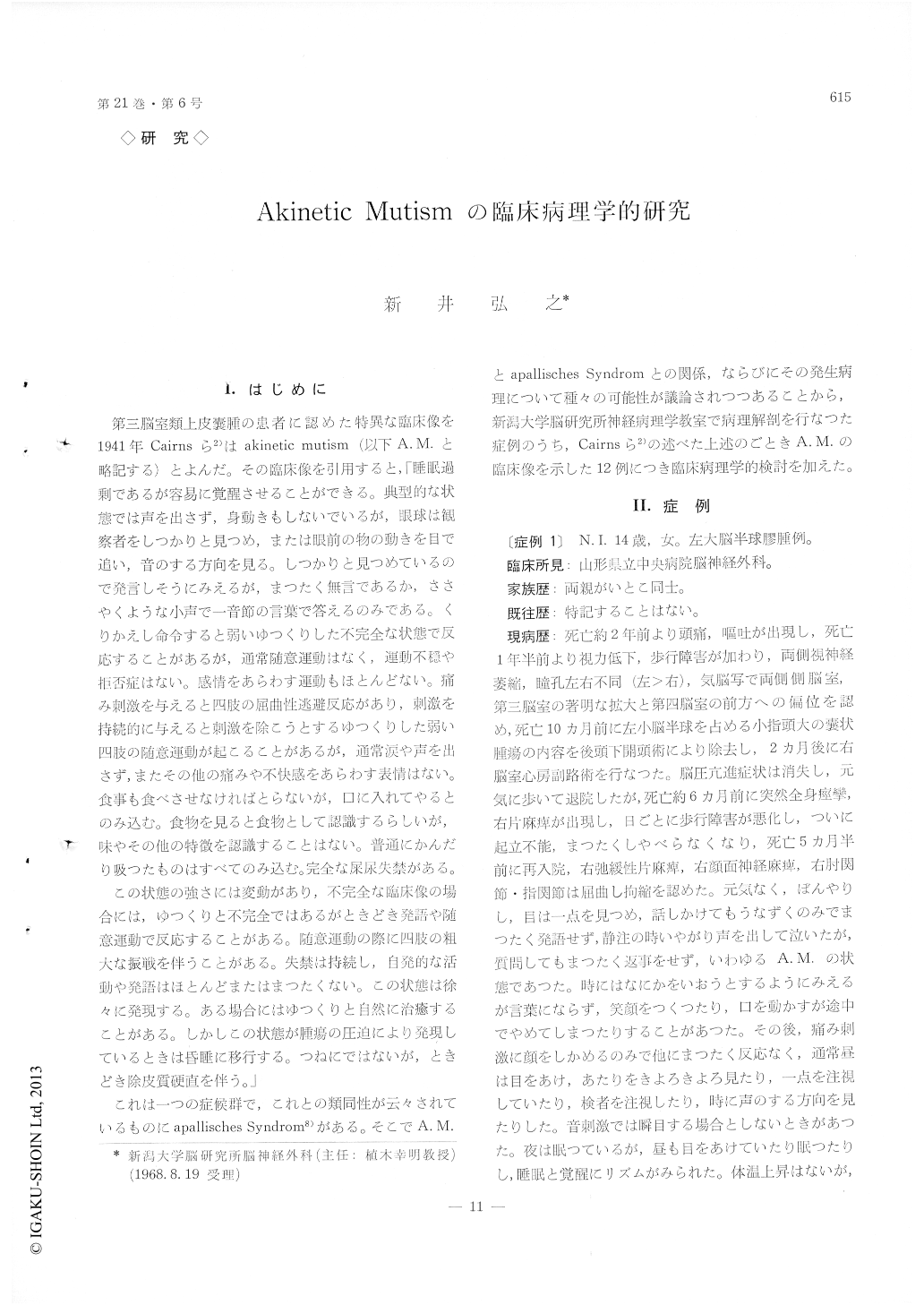Japanese
English
- 有料閲覧
- Abstract 文献概要
- 1ページ目 Look Inside
I.はじめに
第三脳室類上皮嚢腫の患者に認めた特異な臨床像を1941年Cairnsら2)はakinetic mutism (以下A.M.と略記する)とよんだ。その臨床像を引用すると,「睡眠過剰であるが容易に覚醒させることができる。典型的な状態では声を出さず,身動きもしないでいるが,眼球は観察者をしつかりと見つめ,または眼前の物の動きを目で追い,音のする方向を見る。しつかりと見つめているので発言しそうにみえるが,まったく無言であるか,ささやくような小声で一音節の言葉で答えるのみである。くりかえし命令すると弱いゆつくりした不完全な状態で反応することがあるが,通常随意運動はなく,運動不穏や拒否症はない。感情をあらわす運動もほとんどない。痛み刺激を与えると四肢の屈曲性逃避反応があり,刺激を持続的に与えると刺激を除こうとするゆつくりした弱い四肢の随意運動が起こることがあるが,通常涙や声を出さず,またその他の痛みや不快感をあらわす表情はない。食事も食べさせなければとらないが,口に入れてやるとのみ込む。食物を見ると食物として認識するらしいが,味やその他の特徴を認識することはない。普通にかんだり吸つたものはすべてのみ込む。完全な屎尿失禁がある。
この状態の強さには変動があり,不完全な臨床像の場合には,ゆつくりと不完全ではあるがときどき発語や随意運動で反応することがある。随意運動の際に四肢の粗大な振戦を伴うことがある。失禁は持続し,自発的な活動や発語はほとんどまたはまつたくない。この状態は徐々に発現する。ある場合にはゆつくりと自然に治癒することがある。しかしこの状態が腫瘍の圧迫により発現しているときは昏睡に移行する。つねにではないが,ときどき除皮質硬直を伴う。」
Clinical and pathological study was performed on the 12 autopsy cases, all of which revealed clinically the typical signs and symptoms of so-called akinetic mutism. They were, however, associated with a variety of different diseases, such as brain tumors (8 cases : 7 with gliomas and one with multiple metastatic carcinomas), severe head injuries in a chronic state (3 cases) and carbon monoxide poison-ing (1 case).
Two cases (Cases No. 1 and 2) of tumors were noted to involve mainly the cerebrum. One of the cases was medulloblastoma and revealed extensive involvement of the periventricular zones and the left cerebral centrum semiovale, combined with a large fresh hematoma that compressed strongly the adjacent basal ganglia and diencephalon (Fig. 1). Extensive demyelination of bilateral cerebral white matter due to the increased intracranial pressure was also remarkable (Fig. 2). Another case (No. 2) was multiple metastatic tumors, which failed to show, as a contrast to the former, any involvement of the basal ganglia or diencephalon. Those well circum-scribed multiple metastatic tumors occupied selec-tively the subcortical white and partially grey matter of the bilateral frontal, parietal, temporal and oc-cipital lobes. An extensive demyelination of bilateral cerebral white matter was also prominent (Figs. 3, 4,5).
In another case (No. 7) of glioblastoma multiforme of bilateral frontal lobes, akinetic mutism did not appear even after the extensive right frontal lobec-tomy. However, after performing additionally the extensive frontal lobectomy on the other side, immediately followed a sudden onset of akinetic mutism syndrome. Neuropathological examination revealed marked dilatation of both lateral and third ventricles associated with extensive diffuse demy-elination of the bilateral cerebral white matter (Figs. 12,13).
In other two cases, gliomas were located in both supra- and infratentorial regions. One (No. 8) was a case of glioma, diffusely occupying the cerebral white matter, basal ganglia, diencephalon and mid-brain on both sides as well as bilateral corpus cal-losum, fornix and ventricular walls of lateral and third ventricles. (Figs. 14, 15, 16). The other (Case No. 9) was a case of pineal teratocarcinoma, involv-ing extensively the bilateral lateral and third ven-tricles, tegmentum of the midbrain, and rostral portion of the fourth ventricle. Bilateral cerebral white matter, basal ganglia and diencephalon were markedly compressed by the tumor (Figs. 17, 18).
In other three cases (Cases No. 10, 11, 12) of tumors located only in the infratentorial region revealed macroscopically marked atrophy of the cerebral white matter and severe symmetrical dilata-tion of the lateral and third ventricles. Those find-ings are considered to he the result of an increased intracranial pressure which in turn is the result of the Sylvian aqueduct obstruction by a glioma of midbrain central grey matter (Figs. 19, 20), or of the compression of the fourth ventricle by a cerebel-lar glioma (Figs. 21, 22, 23). In another case (No. 12) of cerebellar glioma, no dilatation was noted in the above mentioned ventricles other than the third. Microscopically, however, extensive disintegration and swelling of myelin sheaths were also demon-strated in the cerebral white matter bilaterally (Figs. 24, 25, 26).
In all three cases (Cases No. 3, 4, 5) of severe chronic head injuries marked manifestation of de-layed increase of intracranial pressure was noted and, as a common denominator of neuropathological findings, an extensive degeneration of bilateral cere-bral white matter (Figs. 6, 7, 8, 9) was demonstrated without exception. A case (No. 6) of carbon mono-xide poisoning, in which no clinical or neuropathol-ogical evidence of increased intracranial pressure was found, showed an extensive degeneration of the white matter of bilateral frontal, parietal, tem-poral and occipiral lobes (Figs. 10, 11). In this case, no lesions of the midbrain, pons, medulla oblongata, cerebellum or of the upper cervical cord were ob-served.
Therefore, it should be pointed out that the pre-sence of extensive and diffure demyelinating lesion of the white matter of bilateral cerebral hemispheres was the only common denominator throughout all of the 12 cases associated with akinetic mutism. This was true not only in the cases of traumaticlesion and carbon monoxide poisoning but also in the cases of infratentorial tumors.
Clinically, three cases seemed to follow progres-sively and continuously the symptoms of all of the following four stages that were noted at the time of anesthesia : Stage 1, the development of mental disturbances, stage 2, the development of excitation or delirium, stage 3, the development of akinetic mutism and stage 4, coma. Other three patients seemed to pass through all 4 stages skipping stage 2. Also three cases were noted to have recovered from coma to the stages of akinetic mutism or of mental disturbances and in four cases the recovery was to the stage 3 of akinetic mutism. Therefore, it may be possible to a certain degree that coma may have always occurred after the stage of akine-tic mutism, even if the duration of the akinetic mutism is undetectably short. In other words, the progress from alert consciousness to coma may always go through all of the above described con-tinuous stages skipping occasionally the stage 2.

Copyright © 1969, Igaku-Shoin Ltd. All rights reserved.


